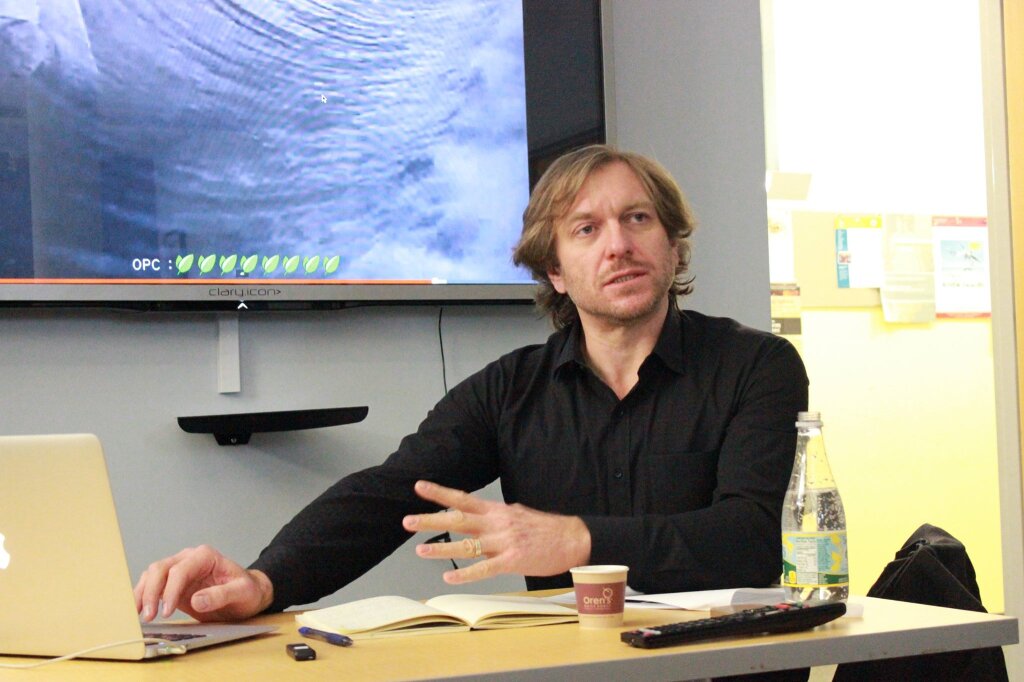On December 11, 2015, the NYU Jordan Center for the Advanced Study of Russia welcomed Robert Bird for a colloquium entitled, “Synchrony and Matriarchy: Documenting Female Subjectivity in Dziga Vertov and Elizaveta Svilova’s documentary The Three Heroines (1939).” The talk focused on Vertov’s final independent film before World War II, which completed a trilogy of films about women in the USSR. Bird, an Associate Professor in the Department of Slavic Languages and Literatures and the Department of Cinema and Media Studies at the University of Chicago, discussed female subjectivity in the context of socialist realism and the Stalinist era, drawing on a portion of his upcoming book manuscript about socialist realism as a model from 1932 to 1941.
In his opening remarks Bird explained that The Three Heroines tells the story of three female aviators who undertook a record-breaking flight from Moscow to the Pacific Ocean on an airplane called “The Motherland” in September 1939. Losing radio contact, the crew made an emergency landing and spent ten days alone in the wilderness. Afterwards, the women gained nationwide fame and were celebrated by Stalin as a triumph of socialist matriarchy.
Bird said that Vertov first heard of the Motherland flight while preparing for another film about women in defense. “He becomes fascinated with Marina Raskova, [the flight’s navigator],” Bird said of the director. However, Vertov and Svilova were barred from filming the flight or the Kremlin reception, and forced to shape their narrative around the men who tracked the Motherland’s flight and rescued the women from the taiga. Despite these constraints, Bird believes that the film shows “how women are able to speak for themselves.”
Bird added that The Three Heroines demonstrates cinematic techniques innovative for the time and divergent from Vertov’s usual methods. According to Bird, these differences indicate that Vertov was “looking for the ‘living person’ – ‘zhivoy chelovek’”– in his work. For the director, the temporality of the footage was important, particularly in regards to the length and synchrony between sound and image. In the rescue scene, there are “sweeping tracking shots that are quite long for the time, especially in documentary cinema,” Bird said. The Three Heroines is also unique in that it retains spontaneity. At the time of its conception, “documentary is becoming a scripted affair and Soviet subjectivity is becoming a scripted affair,” Bird said. The media specialist screened a scene from the film in which Raskova reads a telegram she sent to Stalin after the crew returned home safely. While the scene is scripted, it appears as an impromptu monologue. “She may be repeating an official text, improved as imprimatur of Stalin, but at the same time she is alive,” Bird said.
In many ways, the film is also a microcosm of socialist reality, Bird argued. “Socialist realism came to be as a method of representation that frequently predicated on dramas of scale,” which one can point to in the film.
In terms of representing female subjectivity, Bird said that the issue of gender pervades the entire film. The dialogue between Vertov and Raskova in the process of making the film, as well as the role of Svilova, Vertov’s collaborator, are essential problematics. While “Vertov has an extensive diary of production and the inability to release the film, [...] Svilova is silent” – there is no documentation about her involvement in the filmmaking process on her part, Bird explained. “I want to think about the ways her labor mirrors that of the pilots in a male system, turned always to Stalin, seeking approval and validation.”
At the end of his lecture, Bird said that as his research continues, he wants to think more about the role of the Terror. “I didn’t want to start with that because I felt it would predetermine a lot of things in the film,” he said, but it is unavoidable in a film where visibility and disappearance are essential themes.
In the Q&A session that followed, Bird was able to expand on the work that he foresees for the rest of his book. Eliot Borenstein, Professor of Russian and Slavic Studies at NYU probed Bird on the issue of gender and the role of the body. He problematized Bird’s understanding of the film as appealing to Stalin and therefore representing “Stalinist feminism” as well as portraying Raskova as a “socialist matriarch.” “Stalin’s use of the term ‘matriarch’ is so problematic,” Borenstein said, particularly given that Stalin is a man and the aviators are women. Raskova fulfills the role of the female gender in terms of self-preservation and social reproduction, but this shows her as a mother and as maternal, not as a matriarch. Bird added that one of the main issues in researching the Soviet female subject in the context of The Three Heroines is that there is less footage of women than men in the film. We see the male rescuers suffering through their flight to the Far East, but “we don’t have any representation of these women in the flight,” he said.
In the remaining time, NYU Associate Professor of Comparative Literature and Russian and Slavic Studies Cristina Vatulescu asked whether Bird might consider a narrative that includes his archival research, foregrounding his own process instead of concluding with a feminist narrative. Other comments questioned Vertov’s pioneering use of sound in the film, the importance and caveats of talking about the Terror, and the complex history of the documentary method.



